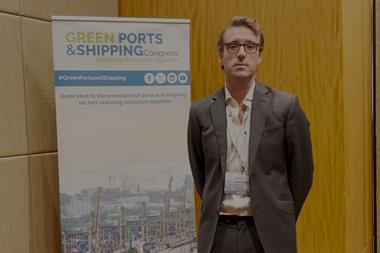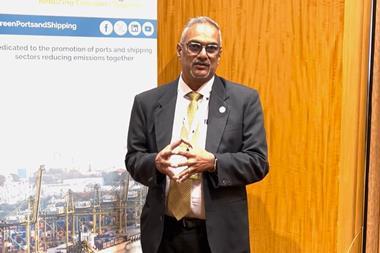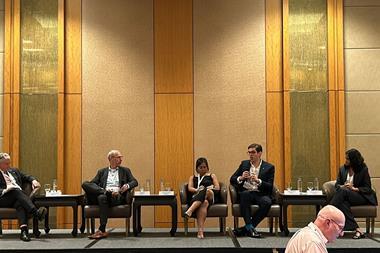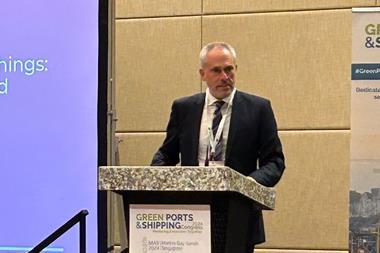”Availability of new fuels and value chain of carbon capture still in flux…” - latest from Green Ports and Shipping Congress.
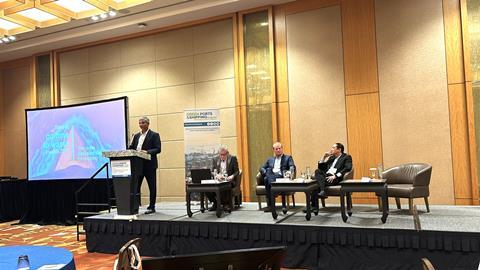
Production and demand are not yet aligned for the transition to low and zero-carbon fuels with faster adoption hinging on deeper ties on new ship propulsion views and the availability of carbon offsets and new infrastructure, according to session one of Green Ports & Shipping Congress taking place on 8 and 9 May, in Singapore.
Speakers in the session first addressed the background to the position today - the International Maritime Organization (IMO) has taken strong steps to support UN Sustainable Development Goal 13 on urgent action to fight climate change in line with the 2015 Paris Agreement to cut greenhouse gas (GHG) emissions.
IMO’s strategy update laid out in July 2023 enhanced the targets to tackle harmful emissions, including the common ambition to reach net-zero GHG emissions from international shipping by or around 2050, and wider use of alternative zero and near-zero GHG fuels by 2030.
The presentations from three key speakers in this field made it rapidly clear that there are still unknowns. Whether the fuels are ammonia, hydrogen, methane and how they are categorized from current production of green or grey are pressing issues – and something of a chicken and egg for the shipping industry and port terminal bunker operations.
“The availability of new fuels and value chain of carbon capture still in flux ahead of 2030 IMO milestones,” said Girish Sreeraman, area business development manager at DNV.
One of the fuels that has captured attention because of its potential compatibility with existing tank and shipping infrastructure, methanol, was said to be four to six years ahead in a world of multi-alternative fuel solutions for shipping, while ammonia is coming along fast, according to Morten Jacobsen, CEO of Denmark-based Green Marine.
“It is relatively easy to use existing tank infrastructure for methanol storage and handling - bunkering can be arranged very quickly,” Jacobsen said
One of the reasons methanol has been cited by Jacobsen and others is because companies in China have made bets on production, shipping and gaining new customers. “China is the driving force in green methanol”.
Still, getting those fuels stocked at exiting terminals in quantities that can meet and grow with demand is a challenge.
“Multi-fuel terminals for shipping need land and flexibility to be able to operate efficiently. It is complex to get it right and adjust to demand,” said Stanley Teo, vice president of business development for Southeast Asia at Advario.
There is also a need to look at how the new fuels can be managed at ports and on ships – with safety concerns expected to drive worker training programmes.
“Seafarers will need upskilling and reskilling as new shipping fuels are introduced. That is a big issue for the industry,” said Girish Sreeraman, area business development manager at DNV.
If successful, however, training coordination and fuel choices can quickly have an impact.
“New alternative-fuelled ships will unlock significant decarbonization that could bridge the gap with long-term goals,” said Andreas Kalamidas, business advisory consultant at Lloyd’s Register, adding that new centres of bunker fuel demand will emerge as a result.
For Australian mining giant Fortescue – a few fuel choice plans are already in the works.
“Green ammonia, green hydrogen in shipping and electrification of vehicles are key to Fortescue’s net-zero goals,” said Andrew Hoare, group manager marine at Fortescue.
Final speaker in the second session of the day, Han Ning, principal consultant at Drewry Maritime Advisors added that the challenges for ports include remaining competitive to be able to seize new opportunities, control costs and obtain green finance as part of ESG (environmental, social and governance) goals.
The concluding facts for delegates to consider was that the IMO GHG strategy envisages a reduction in carbon intensity as an average across international shipping, by at least 40% by 2030 with new technologies, fuels and/or energy sources: to represent at least 5% with a new review expected to set tougher targets in 2028.
Green Ports and Shipping continues tomorrow, Thursday 9 May.


